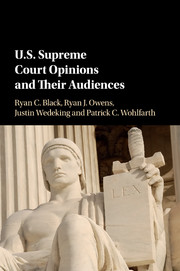Book contents
- Frontmatter
- Dedication
- Contents
- Acknowledgement
- 1 Introduction
- 2 A theory: using opinion clarity to enhance compliance and manage public support
- 3 Estimating the clarity of Supreme Court opinions
- 4 Supreme Court opinions and federal circuit courts
- 5 Supreme Court opinions and federal agency implementors
- 6 Supreme Court opinions and the states
- 7 Supreme Court opinions and the secondary population
- 8 Establishing compliance as a function of clarity
- 9 Conclusion
- References
- Index
3 - Estimating the clarity of Supreme Court opinions
Published online by Cambridge University Press: 05 February 2016
- Frontmatter
- Dedication
- Contents
- Acknowledgement
- 1 Introduction
- 2 A theory: using opinion clarity to enhance compliance and manage public support
- 3 Estimating the clarity of Supreme Court opinions
- 4 Supreme Court opinions and federal circuit courts
- 5 Supreme Court opinions and federal agency implementors
- 6 Supreme Court opinions and the states
- 7 Supreme Court opinions and the secondary population
- 8 Establishing compliance as a function of clarity
- 9 Conclusion
- References
- Index
Summary
The goal of this book is to determine whether justices alter the clarity of their opinions to enhance compliance with their decisions and to manage public support for the Court. This goal is easier set than met, however. Estimating clarity is a difficult endeavor. Clarity might mean doctrinal clarity, cognitive clarity, rhetorical clarity, or clarity of another sort. If we are to examine the clarity of Supreme Court opinions – and whether justices strategically modify clarity – we must be transparent and forthright about how we measure it. That is, we must be clear about how we estimate clarity.
In this chapter, we describe how we empirically estimate opinion clarity in the chapters that follow. We begin by briefly noting several ways previous scholars have measured clarity. These previous attempts examine important concepts. We, however, opt for an alternative approach that relies on textual readability. We focus on the ability of general readers to understand the opinion. Put simply, we examine how easily a member of the public could pick up an opinion, read it, and understand it. An opinion is less readable if it requires extensive education to understand. Conversely, if it requires little education to understand it, an opinion is more readable.
In what follows, we begin by discussing previous efforts to estimate opinion clarity. We then explain how we estimate our measure of clarity. Finally, we offer evidence to validate the measure.
Previous efforts to measure opinion clarity
For years, scholars have employed various approaches to estimate opinion clarity. Some scholars looked simply at the size of the majority coalition, arguing dissents lead to more ambiguous law. Others argue the number of words in a text relate to its clarity, with a greater number of words correlated with increased specificity and, therefore, clarity (see, e.g., Richards, Kritzer, and Smith 2006). In addition to these two approaches, Owens and Wedeking (2011, 1038) identify three other types of clarity: doctrinal, cognitive, and rhetorical. Doctrinal clarity focuses on “how the Court's specific treatment of doctrine [in an issue area] has remained stable or inconsistent … over time” (Owens and Wedeking 2011, 1038). This approach to measuring clarity is perhaps the oldest and most common, but costliest (because it must use laborious human coding). Cognitive clarity addresses the clarity of the underlying ideas being expressed. Rhetorical clarity, which we examine in this book, refers to the nature of an opinion's written content.
- Type
- Chapter
- Information
- US Supreme Court Opinions and their Audiences , pp. 40 - 59Publisher: Cambridge University PressPrint publication year: 2016
- 1
- Cited by

